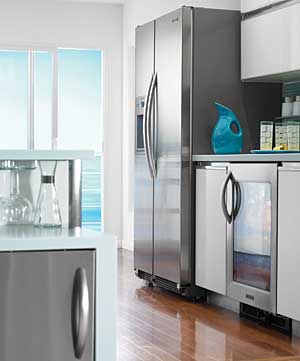Universal Design: Integrating Innovative Products and Spatial Design
The Seven Principles of Universal Design
Led by the Center for Universal Design, a group of architects, designers, engineers, and design researchers established these seven principles. These principles they suggest, are applicable to a wide range of design disciplines, including architecture, interior design, and industrial design. They can be used to evaluate existing products, guide the design process, or educate designers and consumers about the need for universal design.
 |
| Some undercounter beverage centers not only allow accessibility with storage below the counter surface, but also have a glass front to enable the user to see the contents before having to open the unit. |
A full explanation of the seven principles listed below is found in the article of this title on Architectural Record Continuing Education web site. You will also find a method in which to use these seven principles to evaluate the universality of a design.
The seven principles of universal design are:
- Equitable Use:The design does not disadvantage or stigmatize any group of users.
- Flexibility in Use: The design accommodates a wide range of individual preferences and abilities.
- Simple, Intuitive Use: Use of the design is easy to understand, regardless of the user's experience, knowledge, language skills, or current concentration level.
- Perceptible Information: The design communicates necessary information effectively to the user, regardless of ambient conditions or user's sensory abilities.
- Tolerance for Error: The design minimizes hazards and the adverse consequences of accidental or unintended actions.
- Low Physical Effort: The design can be used efficiently and comfortably, and with a minimum of fatigue.
- Size and Space for Approach and Use: Appropriate size and space is provided for approach, reach, manipulation, and use, regardless of the user's body size, posture, or mobility.
These goals should be reached to the greatest extent possible by simplifying design at minimal extra cost. Universal features are generally standard building products or features that have been placed differently, selected carefully, or omitted. Consider the following:
- Accessible route from vehicle drop off or parking
- Covered entryway
- Package shelf or bench to hold parcels, groceries, etc.
- Lever door handles
- Electrical receptacles at 18-inch maximum height
(For a more complete list see the corresponding article on the Architectural Continuing Education web site.)
 |
| Modular work surfaces and storage pedestals can elevate a front-loading washer and dryer, eliminating uncomfortable bending as well as creating a sorting/folding area. |
Universal design is closely associated with human-factors design, although the latter is considered a more rigorous design process. The focus here is on human behavior and human interaction with space, with regard to aesthetics (including color and texture), form, scale, proportion, function, daylight, equipment, and furnishings. Also of importance in human-factors design is establishing a sense of ownership, community, presence, comfort, security, performance, and privacy. In the end, the product is designed "for the user" rather than "forcing" the user to accommodate the design. It's interesting to note that human-factors design is modeled after the process used by the U.S. military in designing its products and facilities. It is a rigorous step-by-step formula.
Perhaps more closely aligned with universal design, particularly in regards to product design, is ergonomics. Generally, ergonomics has come to mean "making something easier and less stressful to use." It is, however much more than that-a well-defined scientific discipline with broad applications and implications in the work environment, product design, and architecture. The uniting element is the assessment of the physical, psychological, and social needs of human beings in all design projects.









